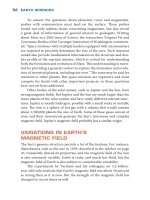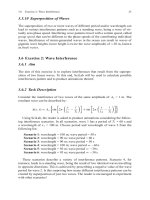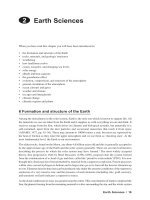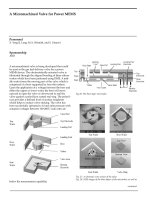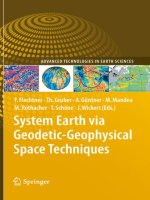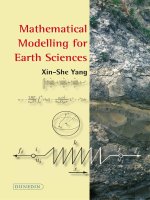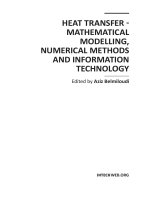Mathematical Modelling for Earth Sciences ppt
Bạn đang xem bản rút gọn của tài liệu. Xem và tải ngay bản đầy đủ của tài liệu tại đây (2.52 MB, 322 trang )
Mathematical
Modelling for
Earth Sciences
Xin-She Yang
DUNEDIN
Finite Element Methods 8.2 Concept of Elements (X. S. Yang)
and at node j, we get
f
j
= f = k(u
j
− u
i
)=−ku
i
+ ku
j
. (8.4)
These two equations can be combined into a matrix equation
k −k
−kk
u
i
u
j
=
f
i
f
j
, or Ku = f. (8.5)
Here K is the stiffness matrix, u and f are the displacement
vector and forcevector, respectively. This is the basic spring
element, and let us see how it works in a spring system such as
shown in Figure 8.2 where three different springs are connected
in serial.
��
��
1
u
1
2
u
2
3
u
3
4
u
4
f
∗
k
1
k
2
k
3
E
1
E
2
E
3
Figure 8.2:Asimple spring system.
For a simple spring system shown in Figure 8.2, we now try
to determine the displacements of u
i
(i =1,2, 3, 4). In order
to do so, we have to assembly the whole system into a single
equation in terms of global stiffness matrix K and forcing f.
As these three elements are connected in serial, the assembly of
the system can be done element by element. For element E
1
,
its contribution to the overall global matrix is
k
1
−k
1
−k
1
k
1
u
1
u
2
=
f
1
f
2
, (8.6)
which is equivalent to
K
1
u = f
E
1
, (8.7)
113
274 Chapter 15. Flow in Porous Media
where D
gb
is the diffusivity of the solute in water along grain boundaries
with a thickness w. D
gb
also varies with temperature T . In fact, we
have
D
gb
(T )=D
0
e
−
E
a
RT
, (15.54)
where D
0
is the diffusivity at reference temperature T
0
. R is the uni-
versal gas constant. E
a
is the effective activation energy with a value
of 5 ∼ 100 kJ/mole depending on the porous materials.
Let c
0
be the equilibrium concentration of the grain materials dis-
solved in pore fluid. Combing Eqs.(15.52) and (15.53), we have
dc
dr
=
ρ
s
v
2D
gb
w
. (15.55)
Integrating it once and using the boundary conditions: c
r
= 0 at r = 0,
c = c
0
at r = L, we have the following steady state solution
c(r)=c
0
−
ρ
s
v
4D
gb
w
(L
2
− r
2
). (15.56)
The parabolic change of concentration c(r) implies that the stress σ(r)
should be heterogeneously distributed in the contact region.
Experimental studies show that both concentration and thin film
thickness depend on the effective stress σ, and they obey the following
constitutive laws
c = c
0
exp(−
ν
m
σ
e
RT
) and w = w
0
exp(−
σ
e
σ
0
), (15.57)
where w
0
,σ
0
are constants depending on the properties of the thin film,
and ν is the molar volume (of quartz). From the relation (15.57), we
have
σ
e
(r)=−
RT
ν
m
ln
c(r)
c
0
, (15.58)
where we have used the condition σ
e
(r)=0atr = L. Let σ be the
averaged effective stress, then
πL
2
σ =
�
L
0
2πσ
e
(r)rdr. (15.59)
Combining (15.58) and (15.59), we have
σ = −
2RT
ν
m
L
2
�
L
0
rln[1 −
ρ
s
˙e
¯
d
4c
0
D
gb
w
(L
2
− r
2
)]dr. (15.60)
Using (15.51) and integrating by parts, we have
σ = −
RT
ν
m
[(1 −
1
BL
2
)ln(1 −BL
2
) −1], (15.61)
92 Chapter 6. Calculus of Variations
�
r
�
�
O
A
B
Figure 6.4: Geodesic path on the surface of a sphere.
and integrating again, we have
y = kx + c, k =
A
√
1 − A
2
. (6.20)
This is a straight line. That is exactly what we expect from the plane
geometry.
Well, you may say, this is trivial and there is nothing new about
it. Let us now study a slightly more complicated example to find the
shortest path on the surface of a sphere.
�
Example 6.2: For any two points A and B on the surface of a sphere
with radius r as shown in Fig. 6.4, we now use the calculus of variations
to find the shortest path connecting A and B on the surface.
Since the sphere has a fixed radius, we need only two coordinates (θ, φ)
to uniquely determine the position on the sphere. The length element ds
can be written in terms of the two spherical coordinate angles
ds = r
dθ
2
+ sin
2
θdφ
2
= r
(
dθ
dφ
)
2
+ sin
2
θ |dφ|,
where in the second step we assume that θ = θ(φ) is a function of φ so
that φ becomes the only independent variable. This is possible because
θ(φ) represents a curve on the surface of the sphere just as y = y(x)
represents a curve on a plane. Thus, we want to minimise the total length
L =
B
A
ds =
φ
B
φ
A
θ
�2
+ sin
2
θ dφ,
where θ
�
= dθ/dφ. Since the integrand
ψ =
θ
�2
+ sin
2
θ
8.2 Concept of Elements (X. S. Yang) Finite Element Methods
to the nodal degree of freedom such as the displacement.
8.2 Concept of Elements
8.2.1 Simple Spring Systems
The basic idea of the finite element analysis is to divide a model
(such as a bridge and an airplane) into many pieces or elements
with discrete nodes. These elements form an approximate sys-
tem to the whole structures in the domain of interest, so that
the physical quantities such as displacements can be evalu-
ated at these discrete nodes. Other quantities such as stresses,
strains can then be be evaluated at at certain points (usually
Gaussian integration points) inside elements. The simplest el-
ements are the element with two nodes in 1-D, the triangular
element with three nodes in 2-D, and tetrahedral elements with
four nodes in 3-D.
In order to show the basic concept, we now focus on the
simplest 1-D spring element with two nodes (see Figure 8.1).
The spring has a stiffness constant k (N/m) with two nodes i
and j. At nodes i and j, the displacements (in metres) are u
i
and u
j
, respectively. f
i
and f
j
are nodal forces.
��
f
i
f
j
k
x
i
j
u
i
u
j
Figure 8.1: Finite element concept.
From Hooke’s law, we know the displacement ∆u = u
j
− u
i
is related to f, or
f = k(∆u). (8.2)
At node i, we have
f
i
= −f = −k(u
j
− u
i
)=ku
i
− ku
j
, (8.3)
112
�
�
�
f
j
f
j
f
j
u
j
Mathematical Modelling for Earth Sciences
•
• •
• • • •
• • •
• • •
• •
Mathematical Modelling for Earth Sciences
Mathematical Modelling
for Earth Sciences
Xin-She Yang
Department of Engineering, University of Cambridge
DUNEDIN
Published by
Dunedin Academic Press ltd
Hudson House
8 Albany Street
Edinburgh EH1 3QB
Scotland
www.dunedinacademicpress.co.uk
ISBN: 978-1-903765-92-0
© 2008 Xin-She Yang
The right of Xin-She Yang to be identied as the author of this work has been
asserted by him in accordance with sections 77 and 78 of the Copyright, Designs
and Patents Act 1988
All rights reserved.
No part of this publication may be reproduced or transmitted in any form or by
any means or stored in any retrieval system of any nature without prior written
permission, except for fair dealing under the Copyright, Designs and Patents
Act 1988 or in accordance with the terms of a licence issued by the Copyright
Licensing Society in respect of photocopying or reprographic reproduction. Full
acknowledgment as to author, publisher and source must be given. Application
for permission for any other use of copyright material should be made in writing
to the publisher.
B
r i t i s h Li B r a r y Ca t a L o g u i n g i n Pu B L i C a t i o n d a t a
A catalogue record for this book is available from the British Library
While all reasonable attempts have been made to ensure the accuracy of
information contained in this publication it is intended for prudent and careful
professional and student use and no liability will be accepted by the author or
publishers for any loss, damage or injury caused by any errors or omissions
herein. This disclaimer does not effect any statutory rights.
Printed in the United Kingdom by Cpod.
Contents
Preface vii
I Mathematical Methods 1
1 Mathematical Modelling 3
1.1 Introduction 3
1.1.1 Mathematical Modelling . . . . . . . . . . . . . . 3
1.1.2 ModelFormulation 5
1.1.3 ParameterEstimation 8
1.2 MathematicalModels 11
1.2.1 DifferentialEquations 11
1.2.2 Functional and Integral Equations . . . . . . . . 16
1.2.3 StatisticalModels 16
1.3 NumericalMethods 17
1.3.1 Numerical Integration . . . . . . . . . . . . . . . 17
1.3.2 Numerical Solutions of PDEs . . . . . . . . . . . 19
1.4 TopicsinThisBook 20
2 Calculus and Complex Variables 23
2.1 Calculus 23
2.1.1 SetTheory 23
2.1.2 Differentiation and Integration . . . . . . . . . . 26
2.1.3 Partial Differentiation . . . . . . . . . . . . . . . 33
2.1.4 Multiple Integrals . . . . . . . . . . . . . . . . . 35
2.1.5 Jacobian 36
2.2 ComplexVariables 38
2.2.1 Complex Numbers and Functions . . . . . . . . . 39
2.2.2 Analytic Functions . . . . . . . . . . . . . . . . . 40
2.3 ComplexIntegrals 41
2.3.1 Cauchy’s Integral Theorem . . . . . . . . . . . . 42
2.3.2 ResidueTheorem 43
i
iii
ii CONTENTS
3 Vectors and Matrices 45
3.1 Vectors 45
3.1.1 Dot Product and Norm . . . . . . . . . . . . . . 46
3.1.2 CrossProduct 47
3.1.3 Differentiation of Vectors . . . . . . . . . . . . . 48
3.1.4 LineIntegral 49
3.1.5 Three Basic Operators . . . . . . . . . . . . . . . 49
3.1.6 Some Important Theorems . . . . . . . . . . . . 51
3.2 MatrixAlgebra 51
3.2.1 Matrix 51
3.2.2 Determinant 53
3.2.3 Inverse 54
3.2.4 MatrixExponential 54
3.2.5 Solution of linear systems . . . . . . . . . . . . . 55
3.2.6 Gauss-SeidelIteration 57
3.3 Tensors 58
3.3.1 Notations 58
3.3.2 Tensors 59
4 ODEs and Integral Transforms 61
4.1 Ordinary Differential Equations . . . . . . . . . . . . . . 61
4.1.1 First-OrderODEs 62
4.1.2 Higher-OrderODEs 64
4.1.3 LinearSystem 65
4.1.4 Sturm-Liouville Equation . . . . . . . . . . . . . 66
4.2 IntegralTransforms 68
4.2.1 FourierSeries 69
4.2.2 FourierIntegral 73
4.2.3 Fourier Transforms . . . . . . . . . . . . . . . . . 74
4.2.4 Laplace Transforms . . . . . . . . . . . . . . . . 75
4.2.5 Wavelets 77
5 PDEs and Solution Techniques 79
5.1 Partial Differential Equations . . . . . . . . . . . . . . . 79
5.1.1 First-OrderPDEs 80
5.1.2 Classification of Second-Order PDEs . . . . . . . 80
5.2 Classic Mathematical Models . . . . . . . . . . . . . . . 81
5.2.1 Laplace’s and Poisson’s Equation . . . . . . . . . 81
5.2.2 Parabolic Equation . . . . . . . . . . . . . . . . . 82
5.2.3 WaveEquation 82
5.3 Other Mathematical Models . . . . . . . . . . . . . . . . 82
5.3.1 ElasticWaveEquation 83
5.3.2 Reaction-Diffusion Equation . . . . . . . . . . . . 83
5.3.3 Navier-Stokes Equations . . . . . . . . . . . . . . 83
iv ConTenTs
CONTENTS iii
5.3.4 GroundwaterFlow 84
5.4 SolutionTechniques 84
5.4.1 Separation of Variables . . . . . . . . . . . . . . 84
5.4.2 Laplace Transform . . . . . . . . . . . . . . . . . 87
5.4.3 Fourier Transform . . . . . . . . . . . . . . . . . 87
5.4.4 Similarity Solution . . . . . . . . . . . . . . . . . 88
5.4.5 Change of Variables . . . . . . . . . . . . . . . . 89
6 Calculus of Variations 91
6.1 Euler-Lagrange Equation . . . . . . . . . . . . . . . . . 91
6.1.1 Curvature 91
6.1.2 Euler-Lagrange Equation . . . . . . . . . . . . . 93
6.2 Variations with Constraints . . . . . . . . . . . . . . . . 99
6.3 Variations for Multiple Variables . . . . . . . . . . . . . 103
6.4 IntegralEquations 104
6.4.1 Fredholm Integral Equations . . . . . . . . . . . 104
6.4.2 Volterra Integral Equation . . . . . . . . . . . . . 105
6.5 Solution of Integral Equations . . . . . . . . . . . . . . . 105
6.5.1 SeparableKernels 105
6.5.2 Volterra Equation . . . . . . . . . . . . . . . . . 106
7 Probability 109
7.1 Randomness and Probability . . . . . . . . . . . . . . . 109
7.2 Conditional Probability . . . . . . . . . . . . . . . . . . 115
7.3 Random Variables and Moments . . . . . . . . . . . . . 116
7.3.1 Random Variables . . . . . . . . . . . . . . . . . 116
7.3.2 Mean and Variance . . . . . . . . . . . . . . . . . 117
7.3.3 Moments and Generating Functions . . . . . . . 118
7.4 Binomial and Poisson Distributions . . . . . . . . . . . . 119
7.4.1 Binomial Distribution . . . . . . . . . . . . . . . 119
7.4.2 Poisson Distribution . . . . . . . . . . . . . . . . 120
7.5 GaussianDistribution 121
7.6 OtherDistributions 123
7.7 TheCentralLimitTheorem 124
7.8 WeibullDistribution 126
8 Geostatistics 131
8.1 Sample Mean and Variance . . . . . . . . . . . . . . . . 131
8.2 MethodofLeastSquares 133
8.2.1 Maximum Likelihood . . . . . . . . . . . . . . . . 133
8.2.2 LinearRegression 133
8.2.3 Correlation Coefficient . . . . . . . . . . . . . . . 136
8.3 HypothesisTesting 137
8.3.1 ConfidenceInterval 137
ConTenTs v
iv CONTENTS
8.3.2 Student’s t-distribution 138
8.3.3 Student’s t-test 140
8.4 DataInterpolation 142
8.4.1 Spline Interpolation . . . . . . . . . . . . . . . . 142
8.4.2 Lagrange Interpolating Polynomials . . . . . . . 149
8.4.3 B´ezierCurve 150
8.5 Kriging 151
II Numerical Algorithms 159
9 Numerical Integration 161
9.1 Root-Finding Algorithms . . . . . . . . . . . . . . . . . 161
9.1.1 BisectionMethod 162
9.1.2 Newton’sMethod 164
9.1.3 IterationMethod 166
9.2 NumericalIntegration 168
9.2.1 TrapeziumRule 168
9.2.2 OrderNotation 170
9.2.3 Simpson’sRule 171
9.3 GaussianIntegration 173
9.4 Optimisation 177
9.4.1 Unconstrained Optimisation . . . . . . . . . . . . 177
9.4.2 Newton’sMethod 178
9.4.3 Steepest Descent Method . . . . . . . . . . . . . 179
9.4.4 Constrained Optimisation . . . . . . . . . . . . . 182
10 Finite Difference Method 185
10.1IntegrationofODEs 185
10.1.1EulerScheme 186
10.1.2Leap-FrogMethod 188
10.1.3Runge-KuttaMethod 188
10.2HyperbolicEquations 189
10.2.1 First-Order Hyperbolic Equation . . . . . . . . . 189
10.2.2 Second-Order Wave Equation . . . . . . . . . . . 190
10.3ParabolicEquation 191
10.4EllipticalEquation 193
11 Finite Volume Method 195
11.1Introduction 195
11.2EllipticEquations 196
11.3HyperbolicEquations 197
11.4ParabolicEquations 198
vi ConTenTs
CONTENTS v
12 Finite Element Method 201
12.1ConceptofElements 202
12.1.1 Simple Spring Systems . . . . . . . . . . . . . . . 202
12.1.2BarElements 206
12.2 Finite Element Formulation . . . . . . . . . . . . . . . . 209
12.2.1 Weak Formulation . . . . . . . . . . . . . . . . . 209
12.2.2GalerkinMethod 210
12.2.3ShapeFunctions 211
12.2.4 Estimating Derivatives and Integrals . . . . . . . 215
12.3HeatTransfer 216
12.3.1 Basic Formulation . . . . . . . . . . . . . . . . . 216
12.3.2 Element-by-Element Assembly . . . . . . . . . . 218
12.3.3 Application of Boundary Conditions . . . . . . . 219
12.4TransientProblems 221
12.4.1TheTimeDimension 221
12.4.2 Time-Stepping Schemes . . . . . . . . . . . . . . 223
12.4.3TravellingWaves 223
III Applications to Earth Sciences 225
13 Reaction-Diffusion System 227
13.1MineralReactions 227
13.2TravellingWave 229
13.3PatternFormation 230
13.4Reaction-DiffusionSystem 231
14 Elasticity and Poroelasticity 235
14.1Hooke’sLawandElasticity 235
14.2ShearStress 240
14.3EquationsofMotion 241
14.4 Euler-Bernoulli Beam Theory . . . . . . . . . . . . . . . 246
14.5AiryStressFunctions 249
14.6FractureMechanics 252
14.7Biot’sTheory 257
14.7.1 Biot’s Poroelasticity . . . . . . . . . . . . . . . . 257
14.7.2EffectiveStress 259
14.8LinearPoroelasticity 259
14.8.1Poroelasticity 259
14.8.2 Equation of Motion . . . . . . . . . . . . . . . . 262
ConTenTs vii
vi CONTENTS
15 Flow in Porous Media 263
15.1GroundwaterFlow 263
15.1.1Porosity 263
15.1.2Darcy’sLaw 263
15.1.3FlowEquations 265
15.2PollutantTransport 269
15.3 Theory of Consolidation . . . . . . . . . . . . . . . . . . 272
15.4ViscousCreep 277
15.4.1Power-LawCreep 277
15.4.2 Derivation of creep law . . . . . . . . . . . . . . 278
15.5Hydrofracture 283
15.5.1Hydrofracture 283
15.5.2Diagenesis 284
15.5.3 Dyke and Diapir Propagation . . . . . . . . . . . 285
A Mathematical Formulae 291
A.1 Differentiation and Integration . . . . . . . . . . . . . . 291
A.1.1 Differentiation 291
A.1.2 Integration 291
A.1.3 PowerSeries 292
A.1.4 ComplexNumbers 292
A.2 VectorsandMatrices 292
A.3 AsymptoticExpansions 293
B Matlab and Octave Programs 295
B.1 GaussianQuadrature 295
B.2 Newton’sMethod 297
B.3 PatternFormation 299
B.4 WaveEquation 301
Bibliography 303
Index 307
viii ConTenTs
Preface
Mathematical modelling and computer simulations are an essential part
of the analytical skills for earth scientists. Nowadays, computer simula-
tions based on mathematical models are routinely used to study various
geophysical, environmental and geological processes, from geophysics to
petroleum engineering, from hydrology to environmental fluid dynam-
ics. The topics in earth sciences are very diverse and the syllabus itself
is evolving. From a mathematical modelling point of view, therefore,
this is a decision to select topics and limit the number of chapters so
that the book remains concise and yet comprehensive enough to include
important and interesting topics and popular algorithms. Furthermore,
we use a ‘theorem-free’ approach in this book with a balance of formal-
ity and practicality. We will increase dozens of worked examples so as
to tackle each problem in a step-by-step manner, thus the style will be
especially suitable for non-mathematicians, though there are enough
topics, such as the calculus of variation and pattern formation, that
even mathematicians may find them interesting.
This book strives to introduce a wide range of mathematical mod-
elling and numerical techniques, especially for undergraduates and grad-
uates. Topics include vector and matrix analysis, ordinary differential
equations, partial differential equations, calculus of variations, integral
equations, probability, geostatistics, numerical integration, optimisa-
tion, finite difference methods, finite volume methods and finite element
methods. Application topics in earth sciences include reaction-diffusion
system, elasticity, fracture mechanics, poroelasticity, and flow in porous
media. This book can serve as a textbook in mathematical modelling
and numerical methods for earth sciences.
This book covers many areas of my own research and learning from
experts in the field, and it represents my own personal odyssey through
the diversity and multidisciplinary exploration. Over these years, I
have received valuable help in various ways from my mentors, friends,
colleagues, and students. First and foremost, I would like to thank my
mentors, tutors and colleagues: A. C. Fowler, C. J. Mcdiarmid and S.
Tsou at Oxford University for introducing me to the wonderful world
of applied mathematics; J. M. Lees, C. T. Morley and G. T. Parks at
Cambridge University for giving me the opportunity to work on the
applications of mathematical methods and numerical simulations in
various research projects; and A. C. McIntosh, J. Brindley, K. Seffan
and T. Love who have all helped me in various ways.
ix
viii CONTENTS
I thank many of my students who have directly and/or indirectly
tried some parts of this book and gave their valuable suggestions. Spe-
cial thanks to Hugo Scott Whittle, Charles Pearson, Ryan Harper, J.
H. Tan, Alexander Slinger and Adam Gordon at Cambridge University
for their help in proofreading the book.
In addition, I am fortunate to have discussed many important topics
with many international experts: D. Audet and H. Ockendon at Oxford,
J. A. D. Connolly at ETHZ, A. Revil at Colorado, D. L. Turcotte at
Cornell, B. Zhou at CSIRO, and E. Holzbecher at WIAS. I would like
to thank them for their help.
I also would like to thank the staff at Dunedin Academic Press for
their kind encouragement, help and professionalism. Special thanks to
the publisher’s referees, especially to Oyvind Hammer of the University
of Oslo, Norway, for their insightful and detailed comments which have
been incorporated in the book.
Last but not least, I thank my wife, Helen, and son, Young, for
their help and support.
While every attempt is made to ensure that the contents of the
book are right, it will inevitably contain some errors, which are the
responsibility of the author. Feedback and suggestions are welcome.
Xin-She Yang
Cambridge, 2008
x PReFACe
Part I
Mathematical Methods
Chapter 1
Mathematical Model ling
1.1 Introduction
1.1.1 Mathematical Modelling
Mathematical modelling is the process of formulating an abstract model
in terms of mathematical language to describe the complex behaviour of
a real system. Mathematical models are quantitative models and often
expressed in terms of ordinary differential equations and partial differ-
ential equations. Mathematical models can also be statistical models,
fuzzy logic models and empirical relationships. In fact, any model de-
scription using mathematical language can be called a mathematical
model. Mathematical modelling is widely used in natural s c iences ,
computing, engineering, meteorology, and of course e arth sciences. For
example, theoretical physics is essentially all about the modelling o f
real world pr ocesses using several basic principles (such as the co nser-
vation of energy, momentum) and a dozen impo rtant equations (such
as the wave equation, the Schrodinger equation, the Einstein equation).
Almost all these equations are partial differential equations.
An importa nt feature of mathematical modelling and numerical al-
gorithms concerning earth sciences is its interdisciplinary nature. It
involves applied mathematics, computer sciences, earth sciences, and
others. Mathematical modelling in combination with sc ientific com-
puting is an emerging interdisciplinary technology. Many international
companies use it to model physical proce sses, to design new products,
to find solutions to challenging problems, and increase their competi-
tiveness in international markets.
The basic steps of mathematical modelling can be summarised as
meta-steps shown in Fig. 1.1. The process typically starts with the
analysis o f a real world problem so as to extract the fundamental phys-
3
4 Chapter 1. Mathematical Modelling
✛
✚
✘
✙
Realworld problem
Physical model
(Idealisation)
Mathematical model Analysis/Validation
(PDEs,statistics,etc) (Data, benchmarks)
✲
✛
Figure 1.1: Mathematical modelling.
ical processes by idealisation and various assumptions. Once an ide-
alised physical model is formulated, it can then be translated into the
corresponding mathematical model in terms of partial differential equa-
tions (PDEs), integral e quations, and statistical models. Then, the
mathematical mo del should be investigated in great detail by math-
ematical analysis (if possible), numerical simulations and other tools
so as to make predictions under appropriate conditions. Then, these
simulation results and predictions will b e validated against the existing
models, well-established benchmarks, and experimental data. If the
results are sa tisfa c tory (which they rarely are at first), then the math-
ematical model can be accepted. If not, both the physical model and
mathematical model will be modified based on the feedback, then the
new simulations and prediction will be validated aga in. After a certain
number of iterations of the whole process (often ma ny), a good math-
ematical model can properly be formulated, which will provide great
insight into the real world problem and may also pre dict the behaviour
of the process under study.
For any physical problem in earth sciences, for example, there are
traditionally two ways to deal with it by either theoretical appro aches o r
field o bservations and experiments. The theoretical approach in terms
of mathematical modelling is an idealisation and simplification of the
real problem and the theoretical models often extract the essential or
major characteristics of the problem. The mathematical equations ob-
tained even for such over-simplified systems are usually very difficult
for mathematical analysis. On the other hand, the field studies and
exp e rimental appro ach is usually expensive if not impractical. Apart
from financial and practical limitations, other constraining factors in-
1.1 Introduction 5
clude the inaccessibility of the loc ations, the range of physical param-
eters, and time for carrying out various exp e riments. As computing
sp e e d a nd power have increased dramatically in the last few decades,
a practical third way or approach is e merging, which is computational
modelling and numerical experimentation based on the mathematical
models. It is now widely acknowledged that computational modelling
and computer simulations serve as a cost-effective alternative, bridging
the gap or co mplementing the tra ditional theoretical and experimental
approaches to problem solving.
Mathematical modelling is essentially an abstract art of formulating
the mathematical models from the corresponding real-world problems.
The master of this art requires practice and experience, and it is not
easy to teach such s kills as the style of mathematical modelling largely
depends on each person’s own insight, abstra c tion, type of problems,
and experience of dealing with similar problems. Even for the same
physical pr ocess, different models could be obtained, depending on the
emphasis of some part of the proc e ss, say, based on your interest in
certain quantities in a particular problem, while the same quantities
could be viewed as unimportant in other processes and other problems.
1.1.2 Model Formulation
Mathematical modelling often starts with the analysis of the physical
process and attempts to make an abstract physical model by ideal-
isation and approximations. From this idealised physical model, we
can use the various first principles such a s the conservation of mass,
momentum, energy and Newton’s law to translate into mathematical
equations. Let us look at the example of the diffusion process of sugar
in a glass of water. We know that the diffusion of sugar will occur if
there is any spatial difference in the s ugar concentration. The physical
process is complicated and many factors could affect the distribution
of sugar concentration in water, including the temperature, stirring,
mass of sugar, type of sugar, how you add the sugar, even geometry
of the container and others. We can idealise the proc e ss by assuming
that the temperature is constant (so as to neglect the effect of heat
transfer), and that there is no stirring because stirring will affect the
effective diffusion coefficient and introduce the advection of water or
even vertices in the (turbulent) water flow. We then choose a represen-
tative e lement volume (REV) whose size is very small compared with
the size of the cup so that we can use a s ingle value of concentration to
represent the sugar content inside this REV (If this REV is too large,
there is considerable variation in sugar concentration inside this REV).
We also assume that there is no chemical reaction between sugar and
water (otherwise, we are dealing with something else). If you drop
6 Chapter 1. Mathematical Modelling
REV
Ω
Γ
❈
❈❲
✒
❍
❍❥
J
dS
Figure 1.2: Representative element volume (REV).
the sugar into the cup from a considerable height, the water inside the
glass will splash and thus fluid volume will change, and this becomes a
fluid dynamics problem. So we are only interested in the process after
the suga r is added and we are not interested in the initial impurity
of the water (or only to a certain degree). With these assumptions,
the whole process is now idealised as the physical model of the diffu-
sion of sugar in still water at a constant temperature . Now we have
to translate this idealised model into a mathematical model, and in
the present case, a parabolic partial differential equation or diffusion
equation [These terms, if they sound unfamiliar, will be explained in
detail in the book]. Let us look at an example.
Example 1.1 : Let c be the averaged conce n tration in a representative
element volume with a vo lume dV inside the cup, and let Ω be an arbitrary,
imaginary closed volume Ω (much larger than our REV but smaller than
the container, see Fig. 1.2). We know that the rate of chan ge of the mas s
of s u gar per unit time ins ide Ω is
δ
1
=
∂
∂t
Ω
cdV,
where t is time. As the mass is conserved, this change of sugar content in
Ω must be supplied in or flow out over the surface Γ = ∂Ω enclosing th e
region Ω. Let J be the flux through the surface, thus the total mass flux
1.1 Introduction 7
through the whole surface Γ is
δ
2
=
Γ
J · dS.
Thus the conservation o f total mass in Ω requires that
δ
1
+ δ
2
= 0 ,
or
∂
∂t
Ω
cdV +
Γ
J · dS = 0.
This i s essentially the integral form of the mathematical model. Using the
Gauss’s theorem (discussed later in this book)
Γ
J · dS =
Ω
∇ ·J dV,
we can convert the surface integral into a volume integral. We thus have
∂
∂t
Ω
cdV +
Ω
∇· JdV = 0.
Since th e domain Ω is fixed (independent of t), we can interchange the
differentiation and integration in the first term, we now g e t
Ω
∂c
∂t
dV +
Ω
∇ ·JdV =
Ω
[
∂c
∂t
+ ∇ ·J]dV = 0.
Since the enclosed domain Ω is arbitrary, the above equation should be
valid for any shape or size of Ω, therefore, the in te grand must be zero. We
finally have
∂c
∂t
+ ∇ ·J = 0.
This is the differential form of the mass conservation. It is a partial dif-
ferential equation. As we know that diffusion occ u rs from the high e r co n -
centration to lower concentration, the rate of diffusion is proportional to
the gradient ∇c of the conce n tration. The flux J over a unit s u rface area
is given by Fick’s law
J = −D∇c,
where D is the diffusio n coefficient which depends o n the temperature and
the type of materials. The negative sign means the diffusio n is opposite
to the gradient. Substituting this into the mas s conservation, we have
∂c
∂t
− ∇ ·(D∇c) = 0,
8 Chapter 1. Mathematical Modelling
or
∂c
∂t
= ∇ ·(D∇c).
In the simplified case when D is constant, we have
∂c
∂t
= D∇
2
c, (1.1)
which is the well-known diffusion equation. This equation can be ap-
plied to study many phenomena such as heat conduction, pore pressure
dissipation, groundwater flow and co nsolidation if we replace D by the
corresponding physical parameters. This will be discussed in greater
detail in the related chapters this book.
1.1.3 Parameter Estimation
Another important topic in mathema tical modelling is the ability to
estimate the orders (not the exact numbers) of certain quantities. If
we know the order of a quantity and its range of variations, we can
choose the right scales to write the mathematical model in the non-
dimensional form so that the right mathematical metho ds c an be used
to tackle the problem. It also helps us to choose more suitable numeri-
cal methods to find the solution over the correct sca les. The estimations
will o ften give us greater insig ht into the physical process, resulting in
more appropriate mathematical models. For example, if we want to
study plate tectonics , what physical scales (forces and thickness of the
mantle) would be appropriate? For a given driving force (from thermal
convection or pulling in the s ubduction zone), could we estimate the
order of the plate drifting velocity? Of course, the real process is ex-
tremely complicated and it is still an o ngoing resea rch area. However,
let us do some simple (yet not so naive) estimations.
Example 1.2: Estimation of plate drifting velocity: we know the drift
of the plate is related to the thermal convection, and the deformation is
mainly governed by viscous creep (discussed later i n this book). The strain
rate ˙e is linked to the driving stress σ by
˙e =
σ
η
,
where η is the viscosity of the mantle and can be taken as fixed value
η = 1 0
21
Pa s (it depends on temperature). The estimation of η will be
discussed in Chapter 15.
1.1 Introduction 9
❄
✻
Earth’s surfac e (T
s
)
heat flow
z
crust
upper mantle
T
0
Figure 1.3: Estimation of the rate of heat loss on the Earth’s surface.
Let L be the typical scale of the mantle, and v be the averag e d drifting
velocity. Thus, the strain rate can be expressed as
˙e =
v
L
.
Combining this equation with the above creep relationship, we have
v =
Lσ
η
.
Using the typical values of L ≈ 3000 km ≈ 3 × 10
6
m, σ ≈ 10
6
Pa, we
have
v =
Lσ
η
≈
3 × 10
6
× 1 0
6
2 × 10
21
≈ 1 .5 ×10
−9
m/s ≈ 4.7cm/year.
This value is about right as most plates move in the range of 1 ∼ 10
cm per year. The other interesting thing is that the accurate values of
σ and L are not needed as long as their product is about the sam e as
Lσ ≈ 3 ×10
12
, the estimation of v will not change much.
If we use L ≈ 1000 km ≈ 10
6
m, then, to produce the same velocity, it
requires that σ = 3×10
6
Pa ≈ 30 atm, or about 30 atmospheric pressures.
Surprisingly, th e driving stress for such large motion is not h u ge. The force
could be easily supplied by the pulling force (due to density difference) of
the subducting slab in the subduction zone.
Let us lo ok at another example to estimate the rate of heat loss at
the Earth’s surface, and the temperature gradients in the Earth’s crust
and the atmosphere. We can also show the importa nce of the sunlight
in the heat energy balance of the atmosphere.
10 Chapter 1. Mathematical Modelling
Example 1.3: We know that the average temperature at the Earth’s
surface is about T
s
= 300K, and the thi c kness of the continental crust
varies from d = 35km to 70km. The temperature at the upper lithosphere
is estimated about T
0
= 900 ∼ 1400K (very crude estimation). Thus the
estimated temperature gradient is abo u t
dT
dz
=
T
0
− T
s
d
≈ 9 ∼ 31K/km.
The observed values of the temperature gradient around th e globe are
ab out 10 to 30 K/km. T h e estimated thermal conductivity k of rock s is
ab out 1.5 ∼ 4.5 W/m K (ignoring the temperature dependence), we can
use k = 3 W/m K as the estimate for the thermal conductivity of the
crust. Thus, the rate of heat loss obeys Fourier’s law of c onduction
q = −k∇T = −k
dT
dz
≈ 0 .027 ∼ 0.093W/m
2
,
which is close to the measured average of about 0.07 W/m
2
. For oceanic
crust with a thickness of 6 ∼ 7 km, the temp e rature gradient (and thus
rate of heat loss) could be five times higher at the bottom of the ocean,
and this heat loss provides a major part of the energy to the ocean so as
to keep it from being frozen.
If this hea t loss goes th rough the atmosphere, then the energy conser-
vation requires that
k
dT
dz
crust
+ k
a
dT
dh
air
= 0,
where h is the height above the Earth’s surface and k
a
= 0.0 20 ∼ 0.025
W/m K i s the thermal conductivity of the air (again, ignoring the variations
with the temperature). Therefore, the tem perature gradient in the air is
dT
dh
= −
k
k
a
dT
dz
≈ −3.6 ∼ −4.5K/km,
if we use dT/dz = 30 W/km. The negative sign means the temperature
decreases as the height increases. The true temperature gradient in dry air
is about 10 K/km in dry air, and 6 ∼ 7K/km in mois t air. As the thermal
conductivity increases with the humi d ity, so the gradient decreases with
humidity.
Alternatively, we know the effective thickness of the atmosphere is
ab out 50 km (if we define it as the thickness of layers containing 99.9%
of the air mass). We know there is no definite bo u n d ary between the at-
mosphere and outer space, and the atmosphere can extend up to several
1.2 Mathematical Models 11
hundreds of kilometres. In addition, we can also assume that the temper-
ature in space vacuum is a bout 4 K and the temperature at the Earth’s
surface is 300K, then the temperature gradient in the air is
dT
dh
≈
4 − 300
50
≈ −6K/km,
which is quite close to the true gradient. The higher rate of heat loss (due
to higher temperature gradient) means that the heat supplied from the
crust is n ot e n ough to balance this higher rate. That is where the energy
of sun light comes into play. We can see that esti m a te s of this kind will
provide a good insight in the whole process.
Of course the choice of typical values is important in order to get a
valid estimation. Such choice will depend on the physical process and
the scales we are interested in. The right choice will be perfected by
exp e rtise and practice. We will give many worked examples like this in
this book.
1.2 Mathematical Models
1.2.1 Differential Equations
The first step of the mathematical modelling process produces some
mathematical equations, often partial differential equations. The next
step is to identify the detailed constraints such as the proper boundary
conditions and initial conditions so that we can obtain a unique set of
solutions. For the sugar diffusion problem dis c ussed e arlier, we cannot
obtain the exact solution in the actual domain inside the water-filled
glass, beca use we need to know where the sugar cube or grains were
initially added. The geometry of the glass also needs to be specified.
In fact, this pro blem needs numerical methods such as finite element
methods or finite volume methods. The only possible solution is the
long-time behaviour: when t → ∞, we know that the concentration
should be unifor m c(z, t → ∞) → c
∞
(=mass of sugar added/volume
of water).
You may say that we know this final state even without mathemat-
ical equations, so what is the use of the diffusion equation ? The main
advantage is that you can calculate the concentration at any time us-
ing the mathematical equation with appropriate boundary and initial
conditions, either by numerical methods in most cases or by ma the-
matical analysis in some very simple cases. Once you know the initial
and boundary c onditions, the who le s ystem history will be determined
to a certain degree. The beauty of mathematical models is that many
12 Chapter 1. Mathematical Modelling
seemingly diverse problems can be reduced to the same mathematical
equation. For example, we know that the diffusion problem is governed
by the diffusion equatio n
∂c
∂t
= D∇
2
c. The heat conduction is governed
by the heat conduction equation
∂T
∂t
= κ∇
2
T, κ =
K
ρc
p
, (1.2)
where T is temperature a nd κ is the thermal diffusivity. K is ther-
mal conductivity, ρ is the density and c
p
is the specific heat capacity.
Similarly, the dissipation of the pore press ure p in por oe lastic media is
governed by
∂p
∂t
= c
v
∇
2
p, (1.3)
where c
v
= k/(Sµ) is the consolidation coefficient, k is the permeability
of the media, µ is the viscosity of fluid (water), and S is the specific
storage coe fficient.
Mathematically speaking, whether it is concentration, temperature
or pore pressure, it is the same dependent variable u. Similarly, it is
just a constant κ whether it is the diffusion coefficient D, the ther-
mal diffusivity α or the consolidation coefficient c
v
. In this sense, the
above three equations are identical to the following parabolic partial
differential equation
∂u
∂t
= κ∇
2
u. (1.4)
Suppo se we want to solve the following problem. For a semi-infinite
domain shown in Fig. 1 .4, the initial condition (whether temperature
or concentration or pore pressure) is u(x, t = 0) = 0. The boundary
condition at x = 0 is that u(x = 0, t) = u
0
=const at any time t. Now
the questio n what is distribution of u versus x at t?
Let us summarise the problem. As this problem is one-dimensio nal,
only the x-axis is involved, and it is time-dependent. So we have
∂u
∂t
= κ
∂
2
u
∂x
2
, (1.5)
with an initial condition
u(x, t = 0) = 0, (1.6)
and the boundary condition
u(x = 0, t) = u
0
. (1.7)
Let us start to solve this mathematical problem. How should we s tart
and where to start? Well, there are many techniques to solve these
1.2 Mathematical Models 13
problems, including the similarity solution technique, Laplace’s trans-
form, Fourier’s tra nsform, separation of variables and others.
Similarity var iable is an interesting and powerful method because it
neatly transforms a partial differential equation (PDE) into an ordinary
differential equation (ODE) by introducing a similarity variable ζ, then
you can use the standard techniques for solving ODEs to obtain the
desired solution. We first define a similar variable
ζ =
x
2
4κt
, (1.8)
so that u(x, t) = u(ζ) = f (ζ). Using the chain rules of differentiations
∂
∂x
=
∂
∂ζ
∂ζ
∂x
=
x
2κt
∂
∂ζ
,
∂
2
∂x
2
= (
x
2κt
)
2
∂
2
∂ζ
2
+
1
2κt
∂
∂ζ
=
ζ
κt
∂
2
∂ζ
2
+
1
2κt
∂
∂ζ
,
∂
∂t
=
∂
∂ζ
∂ζ
∂t
= −
x
2
4κt
2
∂
∂ζ
= −
ζ
t
∂
∂ζ
, (1.9)
we can write the PDE (1.5) for u as
−
ζ
t
f
= κ ·[
ζ
κt
f
+
1
2κt
f
], (1.10)
where f
= df/dζ. Multiplying both sides by t/ζ,
−f
= f
(ζ) +
1
2ζ
f
, or
f
f
= −(1 +
1
2ζ
). (1.11)
Using (ln f
)
= f
/f
and integrating the above equation once, we get
ln f
= −ζ −
1
2
ln ζ + C, (1.12)
where C is an integration constant. This can be written as
f
=
Ke
−ζ
√
ζ
, (1.13)
where K = e
C
. Integrating it again, we obtain
u = f(ζ) = Aerf(
ζ) + B = Aerf(
x
√
4κt
) + B, (1.14)
where
erf(x) =
2
√
π
x
0
e
−ξ
2
dξ, (1.15)
14 Chapter 1. Mathematical Modelling
✲
x
u(x, t=0)=0u=u
0
Figure 1.4: Heat transfer near a dyke through a semi-infinite medium.
is the error function and ξ is a dummy variable. A = K
√
π and B are
constants that can be determined from appropriate boundary condi-
tions. This is the basic solution in the infinite or semi-infinite domain.
The solution is generic because we have not used any of the boundary
conditions or initial c onditions.
Example 1.4: For the heat conduction problem near a magma dyke in a
semi-infinite domain, we can determine the constants A and B. Let x = 0
be the centre of the rising magma dyke so that its temperature is constan t
at the temperature u
0
of the molten magma, while the temperature at the
far field is u = 0 (as we are only interested in the temperature change in
this case).
The boundary condition at x = 0 requires that
Aerf(0) + B = u
0
.
We know that er f(0) = 0, this m e a n s that B = u
0
. From the initial
condition u(x, t = 0) = 0 , we have
A lim
t→0
erf(
x
√
4κt
) + u
0
= 0.
Since x/
√
4κt → ∞ as t → 0 and erf(∞) = 1, we get A + u
0
= 0, or
A = −u
0
. Thus the solution becomes
u = u
0
[1 − erf(
x
√
4κt
)] = u
0
erfc(
x
√
4κt
),
where erfc(x) = 1 − erf(x) is the comple m e n tary error function. The
distribution of u/u
0
is shown in Fig. 1.5.
From the above solution, we know that the temperature variation
becomes significant in the region of x = d such that d/
√
κt ≈ 1 at a
